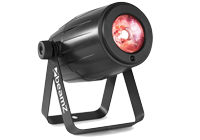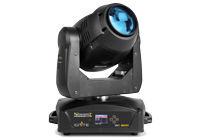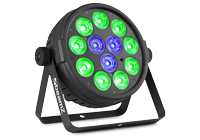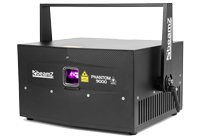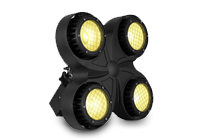Theatre Lighting
Our large range of theatre lighting is suitable for complimenting your play with various effects, such as laser lights, spot lights and wash lights to create immersive atmospheres.
Read More-
BeamZ Apollo Multipoint Disco Laser Light - Red/Green£34.99
- Compact laser light for discos
- 120mW red and 50mW green lasers
- Pre-programmed shows with adjustable speed
- Sound-responsive with modifiable sensitivity
- Included tripod mount for simple desktop placement
In stockIn stock -
BeamZ SB400 LED Stage Blinder 4X Lighting£195.00
- Ultra versatile stage blinder
- 4 very bright COB lights, which can be separated and linked to many others in many ways
- Strobing function, DMX ready with 8 channels
- Dazzle your audience in more ways than one
In stockIn stock -
BeamZ SB200 LED Stage Blinder Lighting£160.00
- Ultra versatile stage blinder
- 2 very bright COB lights, all which can be linked to many others in many ways
- Strobing function, DMX ready with 8 channels
- Dazzle your audience in more ways than one
In stockIn stock -
BeamZ Professional Phantom 2000 Laser Light - 2W Analog RGB ModulationRegular Price £799.00 Special test Price £651.00
- Professional stage laser
- Guaranteed 2W output from the three lasers
- Analog RGB modulation using the ILDA connections
- 25K motors for tight effects and colours
- DMX compatible with 12 or 23 channels
In stockRegular Price £799.00 Special test Price £651.00Free delivery and weekend delivery available
In stock -
-
BeamZ SlimPar35 DMX LED Par Can Light - 12x 3W RGB£67.99
- Powerful mini Par Can light
- Features 12x 3W RGB LEDs with colour mixing
- Standalone mode with pre-programmed shows
- Sound-to-light mode with sensitivity control
- DMX controllable with 3, 4 or 7 channels
In stockIn stock -
BeamZ MHL-74 LED Moving Head Light£130.00
- 7 bulb moving headlight with 12 DMX channels
- Sound sensitive, can be set to react to rhythm
- Strobe and dimmer functions
- Compact yet highly effective
- Great for theatres or live music venues
In stockIn stock -
BeamZ Professional Pandora 1600 Laser Light ProjectorRegular Price £599.00 Special test Price £477.00
- Powerful RGB laser unit
- TTL RGB colour modulation
- 25K optical scanning motors for tight light beams
- DMX compatible with 12 or 23-channel operation
- Sound-activated with adjustable sensitivity
In stockRegular Price £599.00 Special test Price £477.00Free delivery and weekend delivery available
In stock -
BeamZ Pro MHL740 LED Moving Head Wash Lights with Flight Case£2,395.00
- Moving wash lights with flight case
- 7x 40W LEDs per light with individual control
- Plug-and-play operation in master/slave synchronisation
- DMX compatible with RDM protocols for full control
- Sound-activation with fully adjustable sensitivity
In stockIn stock -
BeamZ Professional Fuze75B Moving Head Beam Lights with FlightcaseRegular Price £999.00 Special test Price £679.32
- Moving beam Head Lights and Flightcase
- 10 or 12 DMX channels with strobe, dimmer, tilt and pan functions
- Auto mode operates on pre-programmed shows
- Gobo wheel with 17 different patterns in 12 colours with an open spot for high intensity white LED
- 2° beam/field angle for extremely narrow beam of light
In stockRegular Price £999.00 Special test Price £679.32Free delivery and weekend delivery available
In stock -
BeamZ PRO BWA418 Waterproof LED Par Can Light - IP65 - 18x12W£339.00
- Professional grade par light
- Waterproof housing makes it ideal for outdoor use
- Stand alone mode with pre-programmed light shows
- Up to 9 DMX channels with adjustable strobe effects and multiple preset colour settings
- RGBW colour mixing to manually create any colour you want
In stockIn stock -
BeamZ BT310 Flat LED Par Can LightRegular Price £145.00 Special test Price £130.00
- 12x 6W RGBA LEDs in a Par Can Light
- DMX controllable or sound activated modes
- Automatic shows available and master/slave functionality
- IR remote controllable
- Lightweight-yet-robust ABS housing
In stockRegular Price £145.00 Special test Price £130.00Free delivery and weekend delivery available
In stock -
BeamZ Professional BTF200CZ COB LED Fresnel Theatre Spot Light - RGBW£769.00
- Fresnel spot light 4-in-1 LED
- All aluminium body with detachable barn doors
- 3000k-8000k 200W RGBW COB
- 18-60 degree motor controlled zoom
- Replaces equivalent 1800-2000W halogen lighting
In stockIn stock -
BeamZ Professional BTF100Z COB LED Fresnel Theatre Spot Light - White£579.00
- High power LED fresnel spot light
- Aluminium body with barn doors
- 3200k warm white 100W COB
- 25-65 degree motorized zoom function
- Replaces 800-1000W halogen models
In stockIn stock -
BeamZ PartyBar2 Disco Party Light Bar with Stand - Derby & ParsRegular Price £179.00 Special test Price £119.00
- Party bar kit with tripod light stand
- 2x par cans and 2x derby lights
- 3, 6 or 15 DMX channels and stand alone
- Pre-programmed shows and control panel
- Sound activation with adjustable sensitivity
In stockRegular Price £179.00 Special test Price £119.00Free delivery and weekend delivery available
In stock -
Wireless Uplighter - BeamZ BBP44 Weatherproof Battery UplighterRegular Price £130.00 Special test Price £109.00
- Mini battery-operated uplighter
- Features 4x 4W RGBW LEDs
- Long-lasting battery with up to 25 hours operation time
- IP65 weatherproof rating for outdoor use
- Includes automatic programmes with variable speed
Not quite the right wireless uplighter?
Not quite the right wireless uplighter?
In stockRegular Price £130.00 Special test Price £109.00Free delivery and weekend delivery available
In stock -
MAX PartyBar10 Disco Party Light Bar with Stand - 4-In-1 SystemRegular Price £199.00 Special test Price £149.00
- Party Bar set with tripod stand
- 2x par LEDs and 2x jelly ball LEDs
- 1 UV/strobe 6x 2W UV/white LEDs
- 3 or 16 DMX channels or stand alone mode
- Pre-programmed shows with LED display
In stockRegular Price £199.00 Special test Price £149.00Free delivery and weekend delivery available
In stock -
Wireless Battery Uplighter - BeamZ BBP90 4 x 4W RGB-UV LEDsRegular Price £99.00 Special test Price £82.99
- Battery-powered LED uplighter 4x 4W 4-in-1 RGB UV LEDs
- Up to 20 hours of operating time (depending on the intensity)
- Fast charging time of just 3 hours
- Integrated folding foot for angular position
- DMX in / output via RJ45 (XLR - RJ45 adapter included)
Not quite the right wireless uplighter?
Not quite the right wireless uplighter?
In stockRegular Price £99.00 Special test Price £82.99Free delivery and weekend delivery available
In stock -
BeamZ PRO BWA63 Waterproof LED Par Can Light - IP65 - 6x3WRegular Price £69.00 Special test Price £66.24
- LED Par Can wash light
- 6x 3W RGB LEDs for various colour options
- IP65 waterproof rating for permanent outdoor use
- Infrared remote control for wireless setting adjustments
- Mounting bracket included with an adjustable design
In stockRegular Price £69.00 Special test Price £66.24Free delivery and weekend delivery available
In stock -
Wireless Uplighter Package - 2 x BeamZ BBP90 4 x 4W RGB-UV LEDsRegular Price £180.00 Special test Price £150.00
- Rechargeable battery powered uplighter with up to 20 hours of wireless usage
- 4 RGB LED bulbs have a colour mixing effect to create a variety of colours
- Sound-activated mode responds to music played at a venue for an extremely unique performance
- Auto mode plays through pre-programmed shows with adjustable speeds
- UV light feature acts as a blacklight for additional lighting options
Not quite the right wireless uplighter?
Not quite the right wireless uplighter?
In stockRegular Price £180.00 Special test Price £150.00Free delivery and weekend delivery available
In stock -
MAX PartyBar1 Disco Party Light Bar with Stand - Jellymoon & ParsRegular Price £190.00 Special test Price £99.00
- Bar with par cans, jelly balls and a stand
- RGBW colour mixing
- 3, 6 or 15 DMX channels and stand alone
- Sound activation and adjustable sensitivity
- Pre-programmed shows and control panel
In stockRegular Price £190.00 Special test Price £99.00Free delivery and weekend delivery available
In stock -
BeamZ PS12W LED Pinspot Light for Disco Ball - 12W RGBW£77.99
- Compact LED pinspot light for discos
- Single 12W LED with 4-in-1 RGBW colour mixing
- Adjustable light intensity in nine steps
- Auto mode and sound-activated
- Mounting bracket and remote control included
In stockIn stock -
BeamZ LED Pinspot Light 6W£25.99
- Highly durable 1 x 6W LED white
- Virtually no development of heat
- Low power consumption
In stockIn stock -



